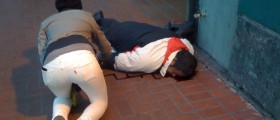
Benign rolandic epilepsy accounts for approximately 15% of all cases of epilepsy in children. It usually starts between the ages of 6 and 8. Adults are never affected by this type of epilepsy. The very name, rolandic, refers to the part of the brain seizures are originating from. This is the brain area responsible for control over the face. Seizures in patients suffering from benign rolandic epilepsy are partial seizures.
The actual cause of benign rolandic epilepsy has not been identified yet. However, children with close relatives who are suffering from the condition are more likely to develop benign rolandic epilepsy themselves.
Clinical Characteristics of Benign Rolandic Epilepsy
As it is the case in other forms of epilepsy benign rolandic epilepsy typically features with seizures. Seizures are generally mild and they begin in the face and may develop in a variety of forms. For example, there may be face and cheek twitching, tingling, numbness or unusual sensations in the tongue or face, difficulty speaking and drooling due to inability to control the mouth muscles.
In some children seizures may spread from the rolandic area to the rest of the brain and cause secondary generalized seizures (tonic-clonic seizures). In such cases unresponsiveness, clenching of muscles all over the body for a short period of time, rhythmic convulsions of the whole body, confusion and disorientation upon regaining consciousness occur.
Benign rolandic epilepsy seizures usually occur during sleep and because of that they may not be noticed at all. And finally, apart from the previously mentioned some children suffering from benign rolandic epilepsy may have learning difficulties and behavioral problems. Such children require additional attention and treatment.
Diagnosing Benign Rolandic Epilepsy
Mild forms of the disease, particularly if seizures develop at night, may remain undiagnosed. On the other hand, some parents notice tonic-clonic seizures and bring their children to a doctor.
Diagnosis is set according to the pattern of seizures and additional test and exams including electroencephalogram (EEG), magnetic resonance imaging (MRI) and neurologic examination.
Treatment for Benign Rolandic Epilepsy
In many cases of benign rolandic epilepsy no treatment is required. The seizures are generally mild, harmless and not so frequent. Proper treatment is necessary if children additionally suffer from learning difficulties, problems thinking or concentrating, behavioral problems, daytime seizures and frequent seizures. Luckily, most children outgrow the condition.

















Your thoughts on this
Loading...